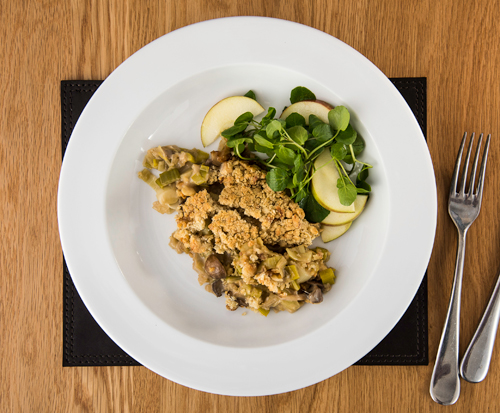Home-grown harvest: Cobnuts
Former Sienna proprietor Russell Brown continues to explore the versatility of seasonal produce, this time looking at a nut popping up on menus all across the country
Hazelnuts, filberts and cobnuts are all the same thing. A cobnut is a cultivated hazelnut, usually sold fresh rather than dried.
At La Fosse at Cranborne, Dorset, they are serving cobnuts as a pre-dinner snack; chef Alan Paton at the Stoke by Nayland hotel is using them in a pork and mackerel dish; Phil Harrison is serving them sautéd with cauliflower and in ice-cream at the Anglesea Arms in Hammersmith in London; and Nathan Eades, head chef at Simpsons Restaurant with Rooms in Birmingham, tells me they are pairing cobnuts with a crispy duck egg, artichoke purée and fresh truffle.
Cobnuts are most commonly associated with Kent, where the bulk of the crop is grown, but they are found all across the UK. There is currently a resurgence in the industry after many years of decline, and this year's crop is likely to be much higher than the 75,000 ton average.
The flavour of cobnuts changes significantly as the nut matures, moving from fresh, green and creamy, to a richer, more earthy flavour with hints of caramel. These flavours become more pronounced if the nuts are roasted. Dried hazelnuts can regain something of the fresh nut flavour by being simmered briefly in milk (this also works well for walnuts).
Cobnuts are high in monounsaturated fats, with a fat content of around 61%. They also contain 12%-17% protein, 10%-15% fibre and are good sources of calcium and vitamin E.
One grower in the West Country is William Hebditch at New Cross Fruit Farm in South Petherton, Somerset. Here, on this 170-acre site, they grow both Corabel and Merveille De Bollwiller varieties, with the season running from August to late October. The nuts from both varieties are surprisingly large and there is a subtle but noticeable difference in flavour. The trees take around four years to produce a crop and yield two to four tons per acre. All the harvesting is done by hand and the biggest part of the cultivation is pruning.
Buying and storage tips
- Treat the nuts as a fresh product and keep them refrigerated in an open container
- Turn each day to prevent them from sweating
- Check frequently and remove any husks that are degrading
Seasonal forecast
The cobnut season usually runs from late August until early October. After the harvest finishes they are still available from refrigerated storage for a couple of months or so. Most cobnuts are from Kent, but there are other orchards across the UK. Expect to pay about £5 per kg.
Charlie Hicks
Venison, cobnut and apple salad
Serves six as a starter
For the venison
- 300g trimmed venison loin
- 3tbs olive oil
- 20g unsalted butter
For the apples
- 3 sharp apples, peeled, cored and cut into eight
- 20g unsalted butter
- 20g caster sugar
- 2tbs cider vinegar
For the dressing
- 1tsp (level) Dijon mustard
- 1tsp (level) honey
- 100ml good apple juice, reduced to 25ml
- 35ml cider vinegar
- 125ml grapeseed oil
- Maldon salt and fresh ground black pepper
To serve
- 60g cobnuts or blanched hazelnuts
- 1 bag watercress, picked, washed and spun dry
- 30g Pecorino Romano
Season the venison loin well with Maldon sea salt and fresh ground black pepper.
In a large frying pan or roasting tray, heat the oil on a medium to high heat. Sear the venison all over, caramelising well, then add the butter and baste.
Transfer to an oven at 200°C for two minutes, turning the loin halfway through. Remove to a cooling rack, rest for 10 minutes and chill if not serving immediately.
Allow to come up to room temperature before serving. Alternatively, the loin can be seasoned and vacuum-packed with 20g of butter. Cook in a waterbath at 48°C for 30 minutes, remove from the bag, dry, and then sear in a hot pan.
Using a non-stick frying pan, cook the apple in two batches. Heat half the butter until it stops foaming, add the apple and sprinkle over half the sugar. Cook over a high heat until well caramelised, then finish with the vinegar and a sprinkle of salt, continuing to cook until the vinegar has evaporated. Put to one side to cool.
To make the dressing, combine the mustard, honey, reduced apple juice and vinegar in a small jug. Blend well together with a hand blender. Slowly blend in the oil and then season to taste. The dressing should be fairly sharp, so add a splash more vinegar if necessary.
Slice the nuts thinly and season with a little salt. Slice the venison loin and season lightly.Dress the watercress and toss with the apple. Divide the salad between the plates and arrange the venison over the top. Scatter over the cobnuts and finish with the Pecorino.
Leek and mushroom cobnut crumble
Serves four as a main course with salad, or 8-10 as a garnish to a main course
For the filling
- Olive oil
- 3 banana shallots, sliced
- 2 garlic cloves, crushed
- 500g chestnut mushrooms, sliced
- 500g trimmed leeks, sliced into ½cm slices
- 500g vegetable stock or a light mushroom stock
- 100ml dry white wine
- 1tsp Dijon mustard
- 75g crème fraÁ®che
- Cornflour to thicken
Sweat the shallots and garlic in some olive oil, add the mushrooms and cook over a high heat for a couple of minutes. Stir in the leeks and add 100g of the stock.
Place a lid on the pan and reduce the heat, cooking for approximately five minutes, until the leeks are tender. Remove the lid from the leek pan and cook over a high heat until the mix is fairly dry.
In a separate saucepan, reduce the wine to a syrup and add the stock. Reduce to 250ml, then add the mustard and crème fraÁ®che and season to taste. Thicken with cornflour to achieve a double cream consistency. Add the sauce to the leek mix and check the seasoning. Transfer to an ovenproof dish or dishes.
For the crumble
- 100g plain flour
- 5g Maldon salt
- 50g oatmeal
- 65g unsalted butter
- 50g chopped cobnuts
- 50g grated Parmesan
- Fresh ground black pepper
Sift the flour and salt into a bowl and stir in the oats. Rub in the butter and then mix in the cobnuts and Parmesan. Season with black pepper. Scatter the crumble mix over the leek base and bake at 170°C for 20-30 minutes, until the top is golden brown.
Russell Brown ran the Michelin-starred, three-AA-rosette Sienna restaurant in Dorchester, Dorset, for 12 years with his wife Eléna. He launched his website and consultancy business Creative about Cuisine earlier this year. He specialises in restaurant consultancy and photography.













